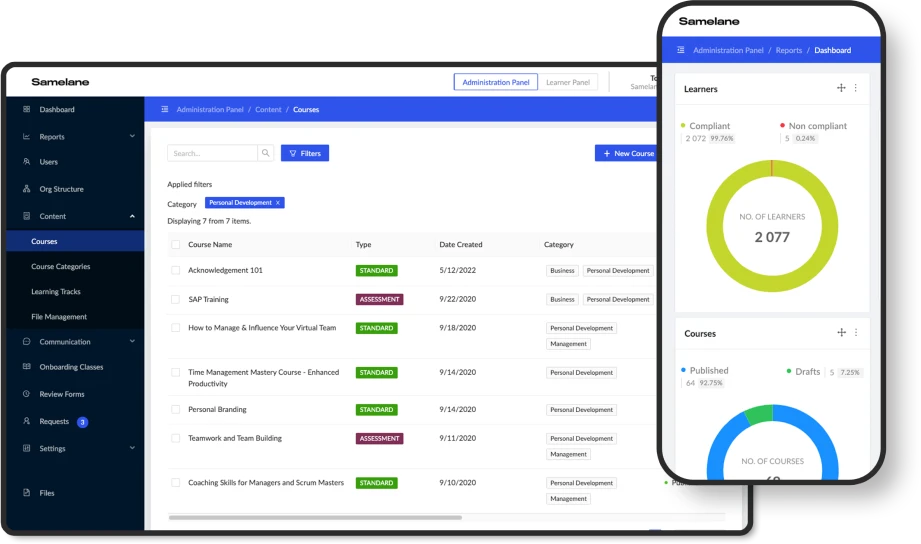Until recently, remote work has been reserved primarily for employees of the creative and IT industries. However, the revolution triggered by the pandemic clearly showed that work from home is possible and effective also among representatives of other branches. Still, though many companies are already used to teleworking and its advantages, it is evident that it also generates many challenges, e.g. related to learning and development. How to train hybrid teams? How to use technology for this purpose?
This article will explain the following:
- What characterizes the hybrid model?
- What are the challenges of managing teams working outside the office?
- What support for hybrid teams does a Learning Management System (LMS) provide?
Hybrid teams – characteristics
The hybrid work model is nothing more than the ability to work partly remotely and partly in-office. Depending on the specificity of the company, its organizational culture, and the type of duties performed by employees, the following variants of the hybrid model are used:
Permanent division – some employees work remotely and the rest are in the in-office mode.
Rotation – the team is divided into groups which switch between remote work or being on the premises. Shifts may change with varying frequency, e.g. every week or month.
Freedom of choice – a model in which the majority of employees generally work from home, but they can come to the office at any time and perform their duties there.
From the employees’ perspective, the hybrid work model is an opportunity to save time and money (no need to travel to the office every day) and, consequently, to improve the work-life balance. On the other hand, working from home requires arranging optimal working conditions, including the costs of organizing a home office and purchasing the necessary equipment.
From the employer’s point of view, the hybrid model is a chance for significant savings; it’s a possibility to free up a part of the occupied office space and reduce operating costs. By offering work from home, a company can also attract new talent, not necessarily from the immediate vicinity, but from the whole country or even from abroad. It is worth noting, however, that the implementation of the hybrid model requires proper preparations. It is crucial not only to build trust within the team, but also to arrange a proper system infrastructure and an efficient cooperation model.
Training hybrid, in-office, and fully remote teams
Implementing a remote or hybrid work model in a company raises a lot of challenges, including the area of L&D. Training and improving the qualifications of employees who work remotely, in shifts, or irregularly in the office requires completely new training policies – reorganized and adapted to the new reality.
For remote and in-office teams, the task is relatively simple. Training methods require adaptation to the shared, homogeneous characteristics of such teams. A problem arises with the need to organize training courses for teams which are composed partly of employees working in-office and partly of teleworkers. How to solve the problem of two different work environments? What tools can be used to allow all course attendees to interact?

One convenient and quick solution is to transfer courses to the online world. It is worth noting, however, that for remote and hybrid teams, training courses play a networking role in addition to the educational one. What’s more, hybrid training courses are more flexible, they allow more students to participate, and – thanks to the use of modern communication platforms – employ diverse and effective education methods.
High effectiveness is another advantage of hybrid training courses. As shown by a study conducted by the US Department of Education, results achieved by online students are slightly better than those achieved by in-house students. However, the best results are ultimately achieved by participants in hybrid training sessions.
The biggest challenges related to training hybrid teams
Hybrid training courses can be organized in many different ways, which will involve individual groups of students. It is, therefore, crucial to develop a model which can provide both on-site and remote students with a chance to actively participate in training sessions and to interact with other participants. For more information on this subject, see the relevant ILT article.
What should be considered before successfully organizing training courses for hybrid teams? How to ensure the optimal experience for all participants? The following points should be taken into account when planning hybrid training courses:
- How will online participants connect with the trainer?
- What applications and tools can be used by both groups of students?
- How to deal with potential technical problems?
- How will trainees interact?
- How will the discussion be moderated to enable everyone to participate equally?
- How will the necessary instructions be communicated to the remote students?
- How will files and materials be shared?
- How to maintain a high level of involvement of all training participants?
By properly approaching these issues and adjusting training strategies to the challenges posed by the hybrid model, it is possible to develop ideal solutions that will satisfy the needs of the company and the students.
Tools helpful in training hybrid teams
There is no doubt that one of the main challenges in hybrid team training is technology. It is important to standardize it sufficiently for all course participants and thus reduce the risk of problems with connectivity, access to training materials, or efficient image sharing.
There are many online messaging and collaboration tools useful in hybrid training courses but a Learning Management System (LMS) is a prime candidate for the corporate world. Modern e-learning platforms not only allow students to participate in training sessions and share training materials, but also significantly facilitate interaction with other participants and trainers. They often also come equipped with tools to design interactive tests, conduct online surveys, and build mind maps.
Additionally, an LMS effectively performs a number of typically administrative tasks; it can be used to plan a training session or course, manage a list of entries, keep track of limits and deadlines, and send individual or group invitations. An e-learning platform will also remind users of upcoming training courses, check attendance, and monitor progress made by the students. Any training session can also be recorded and then made available to those who did not participate or simply want to refresh the acquired knowledge.










